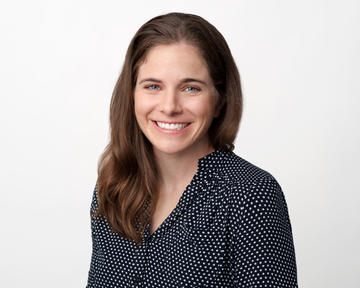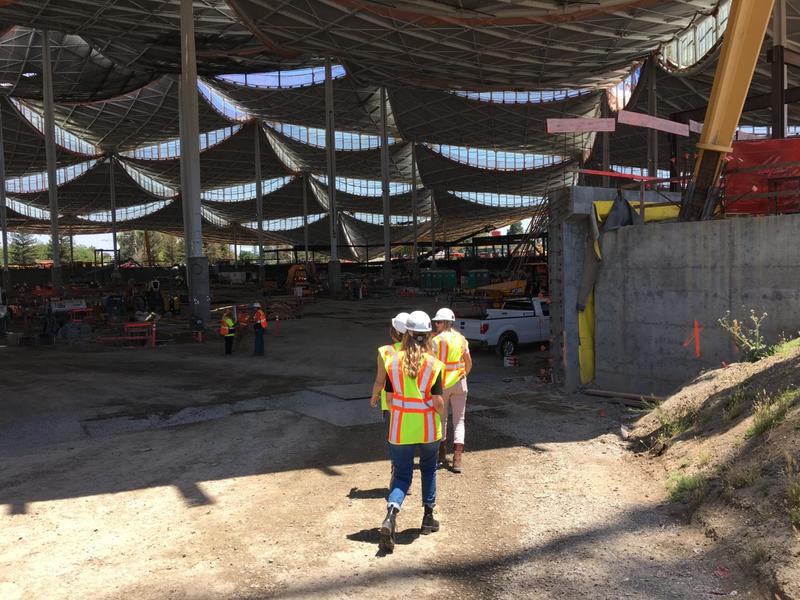Facilities and Footprints at a ‘Circular Google’
Facilities and Footprints at a ‘Circular Google’: An interview with Lauren Sparandara
Jeremy Sigmon is currently pursuing his MSc in water science, policy, and management with the School of Geography and the Environment. He joined Oxford with 15 years of experience in the U.S. green building industry, before which he was a student at Washington University in St. Louis with Lauren Sparandara who was pursuing her own career path in sustainability and architecture that would lead her to Google. Since 2014, Lauren has been a sustainability manager for its Real Estate and Workplace Services (REWS) team.
Efficiency is a natural outcome of good business practice when data reveal waste that can be eliminated with cost-saving alternatives. The circular economy challenges us to employ a “Waste = Food” framing that may require data that is not currently captured. How does a big, global company like Google employ this kind of thinking? The company’s sustainability web page provides many answers to this question. Google is making big investments in renewable energy, slashing the footprint of its data centers, leveraging buying power to yield a more responsible supply chain, and even using web-based data to combat over-fishing. I sat down to talk to Lauren Sparandara about one aspect of the company’s increasingly circular sustainability work, the greening of Google’s buildings.
Jeremy Sigmon (JS): Google is a big company, presumably with a big footprint. How do Google facilities factor in?
Lauren Sparandara (LS): We are indeed a large company with a large footprint. Since the company’s founding we have realized we have the power and responsibility to work towards making the world a more sustainable place. In June of this year, Google furthered its commitment to circularity by releasing a whitepaper entitled “A Circular Google”, in which we laid out our vision for a circular economy: “We want a circular Google within a sustainable world.” We believe we have a truly unique role to play in accelerating the transition to a circular economy. By leveraging our technological assets and know-how, our cultural influence, and our purchasing power, we can be a powerful engine for change.
On the real estate team, our company-wide sustainability goals are implemented by integrating circularity into our buildings. In this way, we deliver sustainability and health outcomes for our offices in more than 160 cities around the world.

Lauren Sparandara, sustainability manager for Google’s Real Estate and Workplace Services (REWS) team.
JS: How do you prioritize the facilities that need the most investment?
LS: It is important to address sustainability in both new and existing buildings and we have REWS Sustainability team members focused on both. To keep on track with our sustainability objectives we often employ green building certifications such as LEED. Google has 11+ million square feet of LEED-certified offices. For many of our offices—existing and new—we are minimizing water, waste, and energy while maximizing good air quality, daylight, and biophilic elements.
Certain projects showcase the sustainability work we’ve been doing for over a decade and allow us to test our assumptions around what is possible. For the last three years, we have been working towards the Living Building Challenge Materials Petal Certification and LEED Platinum certification for Google’s Charleston East project, a ground-up office development in Mountain View, California. It’s one of Google’s most ambitious construction projects to date from both a sustainability and workplace design perspective, applying innovations in renewable energy and healthy materials. We are also aiming for a zero-waste construction site.
JS: Zero waste is a big goal for one project, let alone for all of Google’s footprint. How does your team plan to achieve this?
LS: At Charleston East, zero construction waste to landfill will be achieved initially by design. During construction, we maintain meticulous on-site sorting (with many bins!) for each waste stream to optimize recycling. We are working with local recyclers whenever possible and like to work with RCI-certified construction and demolition (C&D) recycling facilities to ensure greater reliability and transparency for our diversion rates.
We are implementing closed-loop wallboard recycling by sending scrap back to the manufacturer to make more wallboard. Another zero-waste strategy is to pilot emerging technologies for waste reduction such as chemical recycling. A local start-up called Biocellection is helping us recycle thin film plastic—such as tarps and plastic bags—from our construction waste. We know it’s important to find ways to recycle film plastic as these plastics can be blown from construction sites into our drains and waterways and, ultimately, in our oceans.
Across our portfolio, Google is evaluating the value of different zero-waste-to-landfill certifications and determining what role they play in our path to a circular economy. We are finding that third-party certifications can be a great tool for assessing and auditing where we stand with regard to our goals and then using them to track our improvements.

Google’s Charleston East project is pursuing a goal of achieving zero waste.
JS: The Circular Google white paper talks about using design to eliminate both waste and pollution and to maximize the use life of products and materials. How will Google use its influence to realize these objectives?
LS: In REWS, we are always seeking opportunities to design out waste from our built environment by designing buildings to minimize material waste, establishing zero-waste construction practices, and implementing waste reduction strategies in operations. One example of this is building deconstruction. As Google builds more new buildings, we want to be thoughtful about what we do with the buildings that exist on the sites we are developing. When possible, we want to prioritize deconstructing existing buildings and assets so that those materials can be salvaged for reuse. We are currently exploring deconstruction strategies, and ultimately hope to scale a deconstruction approach across our portfolio.
JS: This sounds like fun and important work, Lauren! How can students of the circular economy and social enterprise learn from your work and experience to make an impact?
LS: One tool that might be fun for everyone to check out is “Your Plan, Your Planet”. This site offers simple tips from Google, the California Academy of Sciences, and the Ellen MacArthur Foundation for moving towards a circular economy in your daily life.



